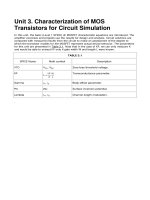Real Astronomy with Small Telescopes doc
Bạn đang xem bản rút gọn của tài liệu. Xem và tải ngay bản đầy đủ của tài liệu tại đây (4.18 MB, 156 trang )
Patrick Moore’s Practical Astronomy Series
Other Titles in this Series
Telescopes and Techniques (2nd Edn.)
Chris Kitchin
The Art and Science of CCD
Astronomy
David Ratledge (Ed.)
The Observer’s Year (2nd Edn.)
Patrick Moore
Seeing Stars
Chris Kitchin and Robert W. Forrest
Photo-guide to the Constellations
Chris Kitchin
The Sun in Eclipse
Michael Maunder and Patrick Moore
Software and Data for Practical
Astronomers
David Ratledge
Amateur Telescope Making
Stephen F. Tonkin (Ed.)
Observing Meteors, Comets, Supernovae
and other Transient Phenomena
Neil Bone
Astronomical Equipment for Amateurs
Martin Mobberley
Transit: When Planets Cross the Sun
Michael Maunder and Patrick Moore
Practical Astrophotography
Jeffrey R. Charles
Observing the Moon
Peter T. Wlasuk
Deep-Sky Observing
Steven R. Coe
AstroFAQs
Stephen Tonkin
The Deep-Sky Observer’s Year
Grant Privett and Paul Parsons
Field Guide to the Deep Sky Objects
Mike Inglis
Choosing and Using a Schmidt-Cassegrain
Telescope
Rod Mollise
Astronomy with Small Telescopes
Stephen F. Tonkin (Ed.)
Solar Observing Techniques
Chris Kitchin
Light Pollution
Bob Mizon
Using the Meade ETX
Mike Weasner
Practical Amateur Spectroscopy
Stephen F. Tonkin (Ed.)
More Small Astronomical Observatories
Patrick Moore (Ed.)
Observer’s Guide to Stellar Evolution
Mike Inglis
How to Observe the Sun Safely
Lee Macdonald
The Practical Astronomer’s Deep-Sky
Companion
Jess K. Gilmour
Observing Comets
Nick James and Gerald North
Observing Variable Stars
Gerry A. Good
Visual Astronomy in the Suburbs
Antony Cooke
Astronomy of the Milky Way: The
Observer’s Guide to the Northern and
Southern Milky Way (2 volumes)
Mike Inglis
The NexStar User’s Guide
Michael W. Swanson
Observing Binary and Double Stars
Bob Argyle (Ed.)
Navigating the Night Sky
Guilherme de Almeida
The New Amateur Astronomer
Martin Mobberley
Care of Astronomical Telescope and
Accessories
M. Barlow Pepin
Astronomy with a Home Computer
Neale Monks
Visual Astronomy Under Dark Skies
Antony Cooke
(continued after index)
Real
Astronomy
with Small
Telescopes
Step-by-Step Activities
for Discovery
Michael K. Gainer
With 90 Figures
Michael K. Gainer
P. O. Box 244
New Derry, PA 15671
USA
British Library Cataloguing in Publication Data
A catalogue record for this book is available from the British Library
Library of Congress Control Number: 2006927794
Patrick Moore’s Practical Astronomy Series ISSN 1617-7185
ISBN-10:1-84628-478-3
ISBN-13:978-1-84628-478-6
e-ISBN-10:1-84628-508-9
e-ISBN-13:978-1-84628-508-0
Printed on acid-free paper.
©Springer-Verlag London Limited 2007
Apart from any fair dealing for the purposes of research or private study, or criticism or review,
as permitted under the Copyright, Designs and Patents Act 1988, this publication may only be
reproduced, stored or transmitted, in any form or by any means, with the prior permission in writing
of the publishers, or in the case of reprographic reproduction in accordance with the terms of licences
issued by the Copyright Licensing Agency. Enquiries concerning reproduction outside those terms
should be sent to the publishers.
The use of registered names, trademarks, etc. in this publication does not imply, even in the absence
of a specific statement, that such names are exempt from the relevant laws and regulations and
therefore free for general use.
The publisher makes no representation, express or implied, with regard to the accuracy of the
information contained in this book and cannot accept any legal responsibility or liability for any
errors or omissions that may be made. Observing the Sun, along with a few other aspects of
astronomy, can be dangerous. Neither the publisher nor the author accepts any legal responsibility
or liability for personal loss or injury caused, or alleged to have been caused, by any information or
recommendation contained in this book.
987654321
Springer Science+Business Media
springer.com
To my son Michael with love and gratitude
No unregarded star
Contracts its light
Into so small a character,
Removed far from humane sight,
But if we steadfast looke
We shall discerne
In it, as in some holy booke
How man may heavenly knowledge learne.
William Habington, 1634
Preface
The small refracting telescope with its simple direct design and construction and
permanently aligned optics is the time tested standard for personal use. Easily
portable, it can be taken out of the house and set up at a moment’s notice. Or,
it can be packed conveniently into a small car for traveling to a dark observing
site. With moderate care and minimal maintenance, the telescope and mount
can last for generations.
These instruments provide sharp, crisp high-contrast images of the Moon
and planets. They are less susceptible to the effects of unstable air than larger
ones, and because of their low maintenance and durability they are ideal for
the parent educator or lifelong learner. Until recently, however, the high cost
of small telescopes of sufficient quality for serious astronomical use has limited
their accessibility.
During the past decade, innovations in optical design and manufacture have
lowered cost and improved quality. Current developments in lens design make it
possible to produce affordable refracting telescopes with shorter tube lengths and
greater versatility. The once very costly 90-mm Maksutov–Cassegrain, with its
optimum combination of effective optics and portability, now sells for a modest
price.
I have often seen small instruments referred to as “grab and go” or “quick
look,” not worthy of consideration for serious observing. I maintain they can be
much more. Despite their limits in types of observation, 80-mm refractors and
90-mm Maksutovs have sufficient aperture and magnifying power to provide a
lifetime of observing pleasure. They are ideal for lunar occultation measurements,
tracking the solar activity cycle, observing variable stars and measuring binary
ix
Preface
x
stars. Although all the activities described here are equally applicable to larger
instruments, none of them require an aperture larger than 80 mm.
Through the use of common digital cameras, the limiting stellar magnitude
and image scale of small telescopes can be increased dramatically, thus providing
results one normally expects from larger instruments. Much of this book applies
that principle to making interesting and useful astronomical observations. I have
taken novel approaches to extending the use of small instruments for quantitative
observations by applying unique methods for the analysis of digital camera
photographs.
My intent is to demonstrate that useful and significant observations can be
made with modest, relatively low cost equipment. Some of the activities described
provide the necessary tools for making valuable contributions to various inter-
national astronomical data files. Others are of primarily educational value for
either the self-learner or the science educator. This material should be of interest
to both the beginning and the experienced observer. The emphasis is on what
you can do with a small telescope rather than only on what you can see.
Acknowledgement
I am deeply indebted to Madalon Amenta for her time and skill in editing the
manuscript.
Michael K. Gainer
June 2006
Contents
Preface ix
Computer Hardware and Software xv
Chapter One The Celestial Sphere 1
Chapter Two The Measurement of Time 5
Solar Time 5
Sidereal Time 7
Dating Observations 8
Chapter Three The Equatorial Telescope Mount 9
Mount Stability 9
The Polar Axis Drive 13
Setting Circles 13
Aligning an Equatorial Mount 15
Using Setting Circles 17
A Tabletop GEM 19
Go-to Mounts 20
Chapter Four Telescope Considerations 21
Limitations Imposed by Aperture 21
Limitations Imposed by the Environment 23
xi
Contents
xii
Limitations Unique to Refractors 23
Short Focus Achromatic Refractors 24
Limitations Unique to Maksutov Telescopes 25
Newtonian Reflectors 25
Eyepieces 26
Focusing 26
The Finder 27
Recommended Accessories 27
Which Small Telescope Should You Buy? 27
Chapter Five Astronomical Photography 29
Digital Photography 29
Choice of Camera 31
Mounting the Camera 31
The Afocal Field of View 31
Telephoto Conversion Lenses 32
Processing the Print 33
Film Photography 34
Printing the Image 35
Chapter Six The Sun 37
Visual Observations of the Sun 39
Classification of Sunspots 39
Sunspot Number 40
Visual Observations 41
Digital Photography of the Sun 42
Processing the Photographs 42
The Stonyhurst Disk 43
Measuring the Sun’s Rotation 48
Film Photography of the Sun 49
Chapter Seven The Moon 51
Visual Observations 51
Digital Camera Photographs of the Moon 52
Analyzing the Photographs 52
Selenography 53
Measurements on the Computer Monitor 56
Measuring Lunar Libration 57
Film Photography of the Moon 59
Lunar Occultations 59
Chapter Eight The Planets 61
Sketching the Planets 61
Filters 62
Digital Photography of the Planets 62
Plotting the Orbital Position of a Planet 64
Ecliptic Coordinates 64
The Phases of Venus 71
Contents
xiii
Mars 71
The Retrograde Motion of Mars 73
Taking the Photographs 73
Plotting the Results 74
Visual Observations of Jupiter 74
Digital Camera Observations of Jupiter 75
Jupiter’s Moons 76
Roemer’s Method for Measuring the Speed of Light 77
Observations for Roemer’s Method 77
Saturn 78
Chapter Nine Comets and Asteroids 79
Comets 79
Visual Observations 80
Digital Photography 82
Serendipitous Comet Discoveries 82
Film Photography 82
Asteroids 83
Digital Photography 83
Tracking an Asteroid 83
Film Photography 89
Chapter Ten Visual Binary Stars 91
Digital Photography of Binary Stars 92
Printing the Images 96
Measuring the Separation of the Components 96
Measuring Position Angle 98
Film Photography 101
Chapter Eleven A Binary Star True Orbit Projector 103
Chapter Twelve Visual Observations of Variable Stars 109
The Telescope 110
Preparation for Observation 110
Making the Observation 113
Chapter Thirteen Photography of Variable Stars 117
Processing the Image 118
The Method of Measurement 118
Making the Measurements 120
Analyzing the Data 120
Film Photography 122
Chapter Fourteen Star Clusters and Nebulae 123
Digital Photography of Star Clusters 125
Chapter Fifteen A Color–Magnitude Diagram for The Pleiades 129
Acquiring the Data 131
The Analysis 132
Contents
xiv
Chapter Sixteen The Design of an Objective Prism Spectrograph 133
Getting the Spectrum 135
Chapter Seventeen The Proper Motion of Barnard’s Star 139
Taking the Photographs 139
References and Additional Reading 143
Star Atlases 143
Telescopes and Accessories 143
Astrophotography 143
TheSun 144
The Moon 144
Binary Stars 144
Variable Stars 144
Star Clusters and Nebulae 144
Index 145
Computer
Hardware and
Software
An essential feature of this book is the application of computer processing and
analysis with small telescopes to obtain data of scientific significance. If you
do not already have an adequate computer and essential ancillary equipment,
consider the following recommendations.
Hardware
The computer I have used for everything described here is equipped with an Intel
Celeron 2.93-GHz processor, 512-MB RAM and an 80-GB hard drive. Slower PCs
with less memory may have difficulty with some of the recommended software.
The computer must have a sufficient number of USB ports to handle a scanner
and digital camera downloads. Ports for various types of digital camera memory
cards are more convenient than USB downloading. A scanner for scanning 35-mm
slides and negatives is also essential.
Software
Although Guide 8.0 doesn’t come with some of the bells and whistles and beautiful
pictures of more expensive software packages, it is the best and least expensive
software available for use with this book. It provides the ability to construct star
charts with labeled magnitudes to the limit of any telescope and for any field
of view. With it you can also label and identify variable stars and asteroids and
xv
Computer Hardware and Software
xvi
obtain all the parameters necessary for observation of the Sun, Moon and Jovian
satellites.
Microsoft Picture It! 7.0 or later editions is a low cost photo processor that
has everything needed for the digital camera photographs associated with the
activities in this book. With it a grid or scale can be superimposed over an image,
faded to transparency and stretched and rotated through a calibrated angle. Any
other software you might choose must have the same capabilities.
CHAPTER ONE
The Celestial
Sphere
In order to make useful observations, it is necessary to establish a reference
frame for making measurements. For all observations of the position of a star or
planet to be related in time and space, certain directions and orientations must
be established as standards. To establish such a standard coordinate system, the
stars can be considered as fixed to a transparent celestial sphere that rotates from
east to west about Earth’s axis once every 24 hours. Figure 1.1 is an illustration of
this imaginary sphere on which standard coordinates are indicated. The following
definitions are referenced to this illustration.
The celestial poles are projections of Earth’s poles onto the celestial sphere.
The celestial equator is the projection of Earth’s equator ( e in Figure 1.1) onto
the celestial sphere.
An observer at the point p on Earth sees a horizon indicated by the plane
NWSE indicating the directions north, west, south and east. The observer’s zenith,
the point directly overhead, is p
. The local meridian is an imaginary line from
the northern horizon, through the north celestial pole, through zenith, to the
southern horizon.
As the Earth moves around the Sun at a rate of about one degree per day
(360
/36525 days), the Sun appears to move around the celestial sphere through
the fixed stars at the same rate. This path of the sun is called the ecliptic. It is
the projection of the plane of the Earth’s orbit onto the celestial sphere.
The point at which the ecliptic crosses the equator, south to north going
eastward, is the vernal equinox. The opposite point of intercept, 180
away, is the
autumnal equinox. The most southern point on the ecliptic is the winter solstice;
1
Real Astronomy with Small Telescopes
2
Figure 1.1. The celestial sphere.
the most northern, the summer solstice. Notice that the equinoxes and solstices
are points on the celestial sphere not times of the year. Spring begins when
the Sun crosses the vernal equinox not when the vernal equinox occurs. In
Figure 1.1, the apparent Sun is indicated by a small circle at the winter solstice.
The vernal equinox is on the eastern horizon. An arrow indicates direction to the
actual Sun.
Due to the gravitational interaction between the Earth and the Moon, the
Earth’s axis precesses around a 23½
cone with a period of 25,800 years relative
to the stars. As a result, the sidereal positions of the equinoxes change with
the same period. For the purpose of establishing a coordinate system, however,
we can consider them fixed.
Since the vernal equinox represents a fixed point on the celestial sphere,
we use this point as the origin of a coordinate system to which we can refer
the positions of stars. Suppose an observer at point p observes a star at point s
on the celestial sphere. We can imagine a great circle running from north through
the star to the celestial equator. We define the angle between this circle and
the circle going through the vernal equinox as the right ascension (RA) of the
star. For reasons explained in Chapter 2, right ascension is measured in hours,
The Celestial Sphere
3
minutes and seconds (0 to 23 hours) eastward from the vernal equinox along the
celestial equator.
We define the angular distance of the point s from the celestial equator as the
declination of a star at that point. Coordinates of declination are parallel to the
celestial equator. They are measured in degrees north or south. North declinations
are +0
to 90
and south −0
to −90
. The coordinates of right ascension and
declination, called equatorial coordinates, are equivalent to longitude and latitude
on the Earth.
CHAPTER TWO
The Measurement
of Time
Solar Time
In antiquity the time of day was measured by the direction of a shadow cast
in sunlight. This resulted in the development of a wide variety of sophisticated
and elegant sundials, which became the standard timekeepers. Sundials were also
used as reference for other modes of time-keeping such as hourglasses.
Time kept by this method is called apparent solar time. The time between
successive appearances of the Sun at the local meridian defines the apparent
solar day. Because of Earth’s elliptical orbit, the angular distance it covers per
day varies. It moves more rapidly in winter when it approaches perihelion than
in summer when it’s near aphelion. As a consequence, the rate at which the
apparent Sun moves eastward along the ecliptic, varies by the same amount. This
causes the time between consecutive appearances of the Sun at the local meridian,
the apparent solar day, to change as the year progresses. In ancient times this
was not seen as a problem. But as more rigorously regulated civil activities and
the expansion of intercontinental trade developed, a more consistent basis for
time-keeping was needed.
Mean solar time was invented as a method for averaging out the inequalities
of apparent solar time. Currently, it is defined in terms of a fictitious Sun that
moves eastward along the celestial equator at a constant rate. The difference
between mean solar time and apparent solar time for any particular date is called
the equation of time.
5
Real Astronomy with Small Telescopes
6
For the convenience of civil activities, mean solar time is divided into global
time zones that progress in increments of 1 hour, or approximately 15
west-
ward, from the Greenwich meridian. For example, the Eastern Standard Time
zone begins at 75
west longitude, making mean solar time for that zone 5 hours
earlier than Greenwich.
The difference between time read on a sundial and a watch (mean solar time)
in minutes is
Apparent Solar time =Watch Time +Equation of Time
The equation of time can be either negative or positive depending on the time
of year.
Sundials can be constructed in a wide variety of forms and are an ideal medium
for combining art and science. Devices can be constructed that compensate for
the equation of time and longitude, and read mean solar time to an accuracy of
one minute.
Horizontal sundials are simply the projection of the equatorial plane onto
a horizontal plane as illustrated in Figure 2.1. The angle the gnomon makes
with the horizontal plane equals local latitude. Vertical dials placed on a south-
facing wall are constructed by the same principle. On those, the gnomon
points downward opposite to the direction of the celestial pole. All forms of
sundial must be aligned with the celestial pole in order to measure apparent
solar time.
Another form of dial is illustrated in Figure 2.2. There the gnomon is the axis
of a semicylinder that points in the direction of the celestial pole. The hour lines,
15
apart, are laid off parallel to the gnomon.
For those of you who would like to apply your esthetic sense to a practical
artistic endeavor, more information can be found in the references at the end of
the book.
Figure 2.1. The horizontal sundial.
The Measurement of Time
7
Figure 2.2. An equatorial sundial.
Sidereal Time
Apparent solar time and mean solar time are both related to consecutive appear-
ances of the Sun or a representation of the Sun at the local meridian. Since the
apparent Sun moves approximately one degree per day eastward relative to the
stars, no form of solar time is useful in making measurements in reference to
the stars.
The sidereal day is the time between consecutive transits of a particular star
across the local meridian. Sidereal time is equal to the right ascension of a star
at the meridian. Conversely, the right ascension of a star is the sidereal time at
which it crosses the local meridian. This, in fact, is the way right ascensions are
measured.
Because of the precession of the Earth’s axis relative to the stars, however, the
sidereal positions of the celestial poles, the celestial equator and the equinoxes
change. In addition, each star has a proper motion relative to other stars. Conse-
quently, the sidereal day is more rigorously defined as the time between the
consecutive transits of the vernal equinox, thus tying it to a fixed reference
frame. The position of the vernal equinox relative to the stars can be determined
by measuring the time at which the Sun during its annual motion crosses the
celestial equator from south to north.
The sidereal day is 3
m
5591
s
shorter than the mean solar day. Since civil
activities are geared to solar time, sidereal time is only useful for astronomical
observations.
Right ascension and declination are defined relative to the vernal equinox
and the celestial equator. The equinox moves westward through the constel-
lations of the zodiac in a 25800-year cycle. As a result, the cataloged values
of equatorial coordinates for the stars are always referred to the position of
the equinox for a particular epoch. For example, the positions for all stars
in the current catalogs are referred to the equinox of 2000.0. The effects of
precession and proper motion on the coordinates of a star are cataloged as
Real Astronomy with Small Telescopes
8
annual variations in right ascension and declination. The exact current position
is determined from the difference between the current time and the catalog
epoch. Except for the nearest stars, the annual variations are fractions of an arc
second.
Dating Observations
No astronomical observation is useful unless the time at which it was made is
recorded. For observations at different geographical locations to be related, it is
necessary for time measurement to be independent of the longitude or civil time
of the observer.
Universal Time (UT), regulated by an international atomic clock, is mean solar
time observed at the Greenwich meridian (GMT). Coordinated Universal Time
is the time given by broadcast time signals.
Observations of phenomena that span long periods of time are dated by the
Julian day, a period of numbered days devised in 1582 by Joseph Justus Scaliger
and named after his father Julius Caesar Scaliger. Scaliger devised this dating
scheme so that references to historic events would be independent of local
calendars. Astronomers have adopted it for the same reasons. The Julian day for
an observation can be obtained from the [Time Set] menu on Guide 8.0. A Julian
day calendar can be downloaded from the American Association of Variable Star
Observers (AAVSO) website.
CHAPTER THREE
The Equatorial
Telescope Mount
For any serious observing with small telescopes, an equatorial mount is essential.
They are commonly used in one of two forms: the German type, referred to as
the GEM, and the fork mount. The first is shown in Figure 3.1; the second in
Figure 3.2. Each has two mutually perpendicular axes for positioning in right
ascension and declination. In the most usable form, both axes are equipped with
calibrated circles for positioning the telescope. The polar axis has a drive for
tracking, and the declination drive has a manual slow-motion control. Sugges-
tions and innovations for addressing some of the flaws and design problems
associated with small telescope mounts follow.
Mount Stability
Since a shaking telescope is nearly impossible to bring into sharp focus, a rigid
mounting is as important as are excellent optics. Slight vibrations produced
by a gentle breeze or a hand touching the focusing knob will adversely affect
observations. This is particularly troublesome with long focus models because of
the greater torque produced by small forces at the eyepiece. Unfortunately, most
imported 80-mm devices have inadequate mounts.
Figure 3.1 illustrates the standard equatorials that come with small telescopes.
The one on the right usually goes by the generic name of EQ2; the one on the left,
EQ3. Eighty-millimeter short tube refractors and 90-mm Maksutov–Cassegrains
are frequently sold with the EQ1 mount. Lighter than the EQ2, it is inadequate
9
Real Astronomy with Small Telescopes
10
Figure 3.1. A comparison of German-type equatorial mounts.
for serious observing. Eighty-millimeter long focus refractors usually come with
the EQ2. Although that mount has a solid base for a short focus refractor or a
90-mm Maksutov, it’s not stable enough to dampen the vibrations induced by
longer tube lengths.
Long focus refractors should be mounted, as the one shown in Figure 3.1, on
the heavier EQ3. Orion sells the mount on the right as the AstroView. Other
vendors sell an equivalent under different names. It’s more stable than the EQ2
and has the added convenience of a built-in polar alignment telescope. Although
a little heavier, it’s still light enough to be easily portable. It costs about $70 USD
more than the EQ2. The best solution is to buy a tube assembly and mount as
separate items.
One of the advantages of the compact 90-mm Maksutov–Cassegrain is that it
can be rigidly placed on an equally compact fork-type equatorial. The tube is
mounted between the tines of a fork, as shown in Figure 3.2. A motor drive is
built into the base of the mount. The base of the fork rotates about the polar
axis, and an axis through the tines of the fork provides rotation in declination.
The tabletop legs provided with some fork mounts are convenient but they
require a rigid table for satisfactory observing. Another disadvantage with this
arrangement is that observing is awkward for some positions of the telescope.
Sufficiently accurate polar alignment for visual observations with tabletop
mounts can be obtained by reference to a magnetic compass. But for photography,
more precise alignment is necessary. A good method for achieving this is to
wait for a sunny day and align the central leg of the mount with its shadow
when the sun is at the local meridian. If you then mark the points where the
The Equatorial Telescope Mount
11
Figure 3.2. A fork-type equatorial mount.
feet of the legs touch the table, providing the table is not moved, you will
have accurate polar alignment in azimuth automatically every time you use the
telescope. Local mean time (watch time) at which the Sun transits your local
meridian can be obtained from Guide 8.0, the RASC Observer’s Handbook or any
other astronomical ephemeris.
Alignment of the polar axis inclination is achieved by setting the declination
circle to read your local latitude when the instrument is pointed to zenith. Place
a level over the objective as shown in Figure 3.3 and adjust the inclination of the
polar axis until the level is zeroed.
If you travel to a remote observing site, perhaps for a lunar occultation
measurement, it is not likely that you will find a suitable table. For such
occasions, a rigid portable tripod will be necessary. These are standard equipment
with the Meade ETX. A few manufacturers are now selling the Maksutov as
a spotting scope without a mount. One can then mount it on a separately
purchased GEM.









